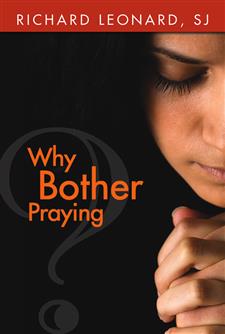
Return to Details Page
Why Bother Praying
Reviewd by: Peter Malone MSC
‘Bother’ is the catchword. For many of us praying can be something of a bother: when to, how to, even why. And then we find, with some irritation that those who do not advocate praying – and who do not advocate God – have at their disposal the phrase ‘God-botherers’. But it’s a bad and somewhat impertinent conclusion to think that those who pray are actually irritating and annoying God – and that God can’t be bothered with us.
‘Why Bother Praying?. Richard Leonard has a way with titles as evidenced by his previous book about his sister and issues of pain and suffering, ‘Where the Hell is God?’. Readers of that book will be wanting to read this one. It is less tough in its subject but no less challenging.
Readers of books on prayer, like Richard himself, will find some of the ideas familiar, of course, but will be interested in how Richard describes them. The approach blends sound reflections on the nature of prayer with an idiosyncratic tone (the personal touch) with a sense of humour and some storytelling. You will probably find yourself warming to the stories – and Richard has the art of storytelling. We chew over some ideas about whom we are praying to, for instance, or a section on Mary and prayer and suddenly there is the story to entertain us so that we don’t just reflect, we feel the reflections and connect with them.
Just a few favourites: Richard as a novice begging his way, 200 kms, from Seven Hills in South Australia, with only enough money for a phone call; Richard fainting at his ordination; the Christmas play in Melbourne with the interfaith touch (you will probably laugh aloud at one stage), and his Uncle Maurice and his distinctive way of praying the rosary (and his pronunciation of the Hail Mary!).
Which means that the spirituality of praying that Richard explores is not some abstract experience. It is part of real life as we discover, prayer for our every mood, our every joy, our every trouble, our every challenge. We are taken through many steps, not as didactic steps, but as invitations to reflect on our experiences but also to learn and experience different ways. Speaking of didactic steps, Richard makes a valiant attempt to invite us to consider different ‘schools of spirituality’, Benedictine, Franciscan, even Dominican, but his Jesuit section is the longest, Ignatian spirituality, and this does have some well-organised didactic steps and a reference to ignatiansprituality.com
Richard guides us towards Jesus and relationship with Jesus as the way for our praying (and highlights a century of Jesus films which offer us images of Jesus, different interpretations of him, a great way of doing some homework on Jesus and prayer. And he has an appendix on films that we might pray with.)
This is not a large book but there is plenty of content, opening our eyes and, as they say, the eyes of the soul, as to what might be the best way of praying at this stage of my life. It is not just inward-looking as it must be at times, but the final chapter and conclusion is praying for mission, outgoing – and Richard lists many of the extraordinary outgoings of the church where contemplation and action are one.








